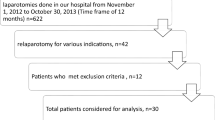Abstract
Introduction
The aim of this work was to analyze preoperative mortality risk factors after relaparotomy for abdominal surgery in a unit of General Surgery at a University Hospital.
Methods
A total of 314 relaparotomies in 254 patients were performed between February 2004 and February 2008. We analyzed data about past medical history, first operation, as well as clinical and biochemical parameters previous to reoperation.
Results
Indications for relaparotomy were peritonitis, bleeding, abscess, exploratory laparotomy, and evisceration. Overall mortality was 22%. Mortality of the patients with a single relaparotomy was 20% vs. 44% if they were reoperated upon twice. Mortality was associated with age, past history of cardiovascular disease, active neoplasm, previous treatment with platelet anti-aggregant drugs, first surgery American Society of Anesthesia score, and the presence of an anastomosis. Preoperative data associated with mortality were the number of systemic inflammatory response syndrome criteria, suture dehiscense, ileus, positive blood cultures, mechanical ventilation, artificial nutrition, antibiotics or vasoactive drugs, tachycardia, and abnormal body temperature. High white blood cell count or bilirrubin levels and low albumin or prothrombin time were also associated with mortality. Multivariate logistic regression analysis isolated age (P = 0.02), abnormal body temperature (P = 0.02), and the need of mechanical ventilation (P = 0.004) as independent preoperative variables predictive for mortality after relaparotomy.
Conclusions
Advanced age, the presence of either fever or hypothermia, and the need of mechanical ventilation are preoperative risk factors associated with mortality after relaparotomy and should be considered when planning reintervention.



Similar content being viewed by others
References
Ching SS, Muralikrishnan VP, Whiteley GS (2003) Relaparotomy: a five-year review of indications and outcome. Int J Clin Pract 57:333–337
Unalp HR, Kamer E, Kar H et al (2006) Urgent abdominal re-explorations. World J Emerg Surg 1:10
Sautner T, Gotzinger P, Redl Wenzl E et al (1997) Does reoperation for abdominal sepsis enhance the inflammatory host response? Arch Surg 132:250–255
Bunt TJ (1985) Urgent relaparotomy: the high-risk, no-choice operation. Surgery 98:555–560
Wain M, Sykes P (1987) Emergency abdominal re-exploration in a district general hospital. Ann R Coll Surg Engl 69:169–174
Calandra T, Cohen J (2005) The International Sepsis Forum Consensus Conference on definitions of infections in the intensive care unit. Crit Care Med 33:1538–1548
Tera H, Aberg C (1975) Relaparotomy. A ten-year series. Acta Chir Scand 141:637–644
Zer M, Dux S, Dintsman M (1980) The timing of relaparotomy and its influence on prognosis. A 10 year survey. Am J Surg 139:338–343
Keller E, Neher M, Schuster HP (1983) Relaparotomy, retrospective analysis and intensive care aspects. Langenbecks Archiv fur Chir 360:167–177
Harbrecht PJ, Garrison RN, Fry DE (1984) Early urgent relaparotomy. Arch Surg 119:369–374
Ross SE, Morehouse PD (1986) Urgent and emergent relaparotomy in trauma. A preventable cause of increased mortality. Am Surg 52:308–311
Hinsdale JG, Jaffe BM (1984) Re-operations for intra-abdominal sepsis. Indications and results in a moern critical care setting. Ann Surg 199:31–36
Osipov AP, Bazunov VA (1988) The problem of relaparotomy in emergency surgery. Vestn Khir Im I I Grek 140:71–74
Pusajó JF, Bumaschny E, Doglio GR et al (1993) Postoperative intraabdominal sepsis requiring reoperation: value of a predictive index. Arch Surg 128:218–222
Sytnik AL, Kononenko NG, Neustroev VN et al (1988) Relaparotomy. Klin Khir 4:18–20
Koperna T, Schulz F (2000) Relaparotomy in peritonitis: prognosis and treatment of patients with persisting intraabdominal infection. World J Surg 24:32–37
Hutchins RR, Gunning MP, Lucas DN et al (2004) Relaparotomy for suspected intraperitoneal sepsis after abdominal surgery. World J Surg 28:137–141
Visokai V, Lipska L, Bergmann P et al (2006) Re-laparotomy for complications of urgent abdominal disorders. Rozhi Chir 85:180–185
Mulier S, Penninckx F, Verwaest C et al (2003) Factors affecting mortality in generalized postoperative peritonitis: multivariate analysis in 96 patients. World J Surg 27:379–384
Campillo-Soto A, Flores-Pastor B, Soria-Aledo V et al (2006) The POSSUM scoring system: an instrument for measuring quality in surgical patients. Cir Esp 80:395–399
van Ruler O, Lamme B, Gouma DJ et al (2007) Variables associated with positive findings at relaparotomy in patients with secondary peritonitis. Crit Care Med 35:468–476
Gibbs J, Cull W, Henderson W et al (1999) Preoperative serum albumin level as a predictor of operative mortality and morbidity: results from the National VA Surgical Risk Study. Arch Surg 134:36–42
Mosdell DM, Morris DM, Voltura A et al (1991) Antibiotic treatment for surgical peritonitis. Ann Surg 214:543–549
Bunt TJ (1986) Non-directed relaparotomy for intra-abdominal sepsis. A futile procedure. Am Surg 52:294–298
van Ruler O, Mahler CW, Boer KR et al (2007) Comparison of on-demand vs planned relaparotomy strategy in patients with severe peritonitis: a randomized trial. JAMA 298:865–872
Hau T, Ohmann C, Wolmershauser A et al (1995) Planned relaparotomy vs relaparotomy on demand in the treatment of intra-abdominal infections. The Peritonitis Study Group of the Surgical Infection Society-Europe. Arch Surg 130:1193–1196 discussion 6-7
Gotzinger P, Gebhard B, Wamser P et al (1996) Revision of diffuse pritonitis: planned versus on demand. Langenbecks Archiv Chir 381:343–347
Holzheimer RG, Gathof B (2003) Re-operation for complicated secondary peritonitis—how to identify patients at risk for persistent sepsis. Eur J Med Res 8:125–134
Velmahos GC, Degiannis E, Souter I (1998) Relaparotomies for abdominal sepsis—why, when, how? A collective review. South Afr J Surg 36:52–56
Rakic M, Popovic D, Druzijanic N et al (2005) Comparison of on-demand vs planned relaparotomy for treatment of severe intra-abdominal infections. Croat Med J 46:957–963
Author information
Authors and Affiliations
Corresponding author
Rights and permissions
About this article
Cite this article
Martínez-Casas, I., Sancho, J.J., Nve, E. et al. Preoperative risk factors for mortality after relaparotomy: analysis of 254 patients. Langenbecks Arch Surg 395, 527–534 (2010). https://doi.org/10.1007/s00423-009-0538-0
Received:
Accepted:
Published:
Issue Date:
DOI: https://doi.org/10.1007/s00423-009-0538-0



